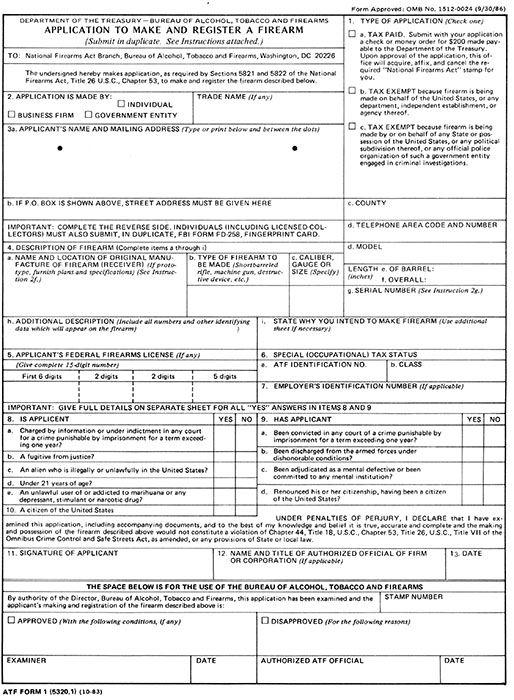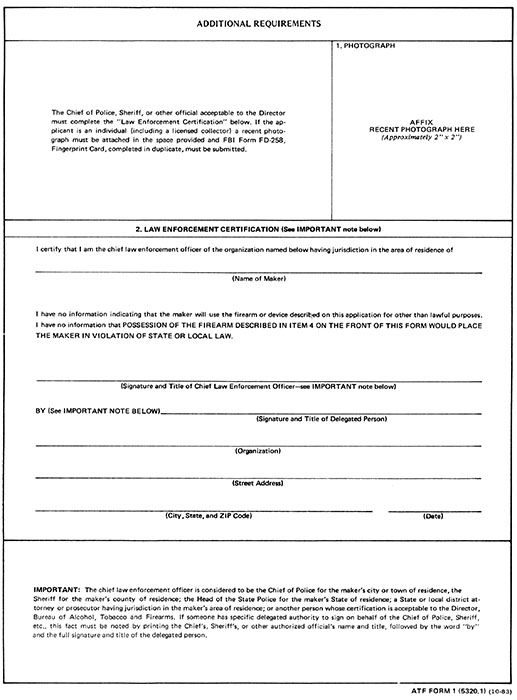By Jeff W. Zimba
Once introduced to the community of Class 3 firearms, we all seem to learn a new language. It would appear to one who is not involved in gun collecting that we have regressed to speaking in numbers, or advanced to some sort of code language, but either way, we can not ignore its presence. Numerous times I have seen the confused and “I really have no idea what you are talking about” look on many a spouse’s face when the conversations begin. The conversations I am writing about are in reference to discussing the ATF forms.
All it takes are a few stops at a gun shop that sells NFA firearms, and you start to pick up this new lingo as well. Rather than explain that a machine gun is transferable, and owned by an individual, often it is simply referred to as a Form 4 Gun. When you are traveling out of State to a shoot or competition, you have to be sure to have your 5320 in, well ahead of time. If your NFA firearm needs repair, you can Form 5 it to another dealer. When a manufacturer builds a new machine gun, he has to Form 2 it. I think you get the picture.
Of all these forms, it is without a doubt that the most popular ATF form is the Form 4. After all, this small piece of paper is actually the welcome letter of our induction into the Class 3 world. The coveted Form 4, when received for the first time, is often erroneously referred to as a machine gun license, a class three license, or even a federal machine gun permit. In actuality it is simply a TAX record for an NFA firearm. Next to the birth certificate and the marriage license, many enthusiasts consider their first approved Form 4 an irreplaceable document.
If you are reading this publication you are probably familiar with the ATF Form 4, so in this writing, I hope to shed a little light on a lesser known form. This form may soon become your favorite, as it can open many doors for you in your quest for a larger Class 3 collection. As with all other aspects of Class 3 ownership there are misconceptions about the Form 1, and I will try to clear some of them up for you here.
The ATF Form 1 (5320.1) is the Application To Make And Register a Firearm. This form is required by Sections 5821 and 5822 of the National Firearms Act, Title 26 U.S.C., Chapter 53 to manufacture and register NFA firearms. This is the form that an individual must submit prior to making an NFA firearm.
Contrary to popular belief an individual can still manufacture firearms for his / her own private collection and use. It is not necessary to be licensed as a firearm manufacturer unless you are making firearms as a business, or for resale. For the most part, there is very little paperwork necessary for an individual to worry about, at least until you get to Title II firearms. This is where the Form 1 comes in.
It IS lawful for an individual to manufacture short-barreled shotguns, short-barreled rifles, sound suppressors, A.O.W.’s and destructive devices for their own collection. In a nutshell, the only firearms an individual may not manufacture for private ownership on a Form 1 are machine guns.
The manufacturing tax is $200.00 and is due upon submission of the form. I know what many of you are thinking right now, and the answer is “Yes, even if you are making an A.O.W.” The MANUFACTURING TAX is $200.00 on every NFA firearm, no matter what classification it falls under. If it were an A.O.W., any subsequent transfer would only be a $5.00 tax, but that is a TRANSFER TAX.
For those not familiar with this form, the information required on a Form 1 is very similar to that on a Form 4. It is necessary to provide Uncle Sam with your name, address, and phone number. As for information regarding your intended firearm, they ask for the name of the original manufacturer of the receiver if you are re-manufacturing someone else’s Title I firearm into a title II, the type of firearm, caliber or gauge, model, length of barrel, length overall, and the serial number.
Unlike a form 4, there is an applicant certification on the front of the Form 1. You must answer the same questions that appear on the ATF Form 4473. (Commonly referred to as the Yellow Sheet. This is the one you fill out at the gun shop on every firearm purchase.) You must attach a passport style photo to the back of this form and bring it to your Chief Law Enforcement Officer (CLEO). Your CLEO certifies that he has no reason to believe you will use this proposed firearm for unlawful purpose, nor will you be in violation of any state or local law.
This form is completed in duplicate, and mailed to the NFA Branch of the BATF along with two completed fingerprint cards (FBI Form FD-258), and the $200.00 check made payable to the Department of the Treasury. These fingerprint cards must be supplied by ATF. Your wait is now on. A reasonable amount of time for approval of this form is in the 90-day range.
You can use the Form 1 to manufacture a firearm from scratch, or to remanufacture an existing title 1 firearm into an NFA firearm. A few popular remanufacturing projects include changing the barrel length of a shotgun to less than 18 inches, and remanufacturing Title 1 receivers to destructive devices. In the case of the latter, an individual who lives in an area with no destructive device dealer and wishes to own an M-203 or M-79 grenade launcher, may purchase the bare receiver through a regular FFL dealer and remanufacture it as a destructive device at a later date. When the approved form is returned, the barrel and the remainder of parts can be installed. It is at this time that the destructive device is completed. The barrel cannot be originally from that firearm and it cannot come from the dealer who sold the original receiver.
One very important thing to remember is that you can not start making the firearm you have filed the application for until it comes back approved. This could get you in trouble real quick. If you are manufacturing a short-barreled shotgun you can have the shotgun in your possession in its original title 1 configuration, but DO NOT cut the barrel until the tax stamp is in your possession. You must also make sure that you do not have any combination of parts in your possession that could get you in trouble either. If you have a Remington 870, and you purchase a 12” barrel at a gun show before your Form 1 is approved and returned, you are guilty of conspiracy to manufacture an illegal, short-barreled shotgun. Even though the parts are not assembled, you can still get hit for possession. This also stands true with grenade launcher receivers. A bare receiver is considered a Title 1 firearm, but once you are in possession of a barrel as well, you have a destructive device, requiring registration under Title II. Do a little homework as to what parts can get you into trouble. Do not purchase them until your form is approved.
It is a little more complicated and equally important when you are building a sound suppressor. Unlike other firearm projects, you can not have ANY suppressor parts in your possession until the form is approved.
The Main part of the sound suppressor is the tube. Similar to the lower receiver of an M-16, this is the registered piece and is treated as the firearm. This is where the similarity to other NFA firearms ends and it gets a little complicated. BATF has disallowed possession of ANY suppressor part, except by qualified Class 2 persons or businesses. To make it simple, no one can possess any suppressor parts unless they are a Class 2 Manufacturer. This includes individuals who own suppressors, and even class 3 dealers. Suppressor parts can include end caps, baffles, wipes, diffuser sections, and obviously, the tube.
If you own a suppressor that needs to have the baffles replaced, or needs to be rebuilt, you must ship it to a manufacturer on an approved form 5 for repair. You can not simply buy a few baffles, nor can you just build them yourself. However, it has always been my understanding that if you are the manufacturer of a suppressor on a Form 1, you may maintain it yourself. Just do not be manufacturing any spare parts. This being the case, it is imperative that you do not start construction of a sound suppressor until you receive the approved Form 1.
If you decide to enhance your collection by adding a few Form 1 guns, make sure you educate yourself about the project you are working on. Safety has to be your top priority. You can request ATF forms by calling the ATF Distribution Center at (703) 455-7801, or writing them at: PO Box 5950, Springfield, Virginia 22153. Be safe and have fun.


| This article first appeared in Small Arms Review V1N10 (July 1998) |










